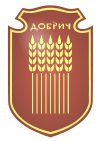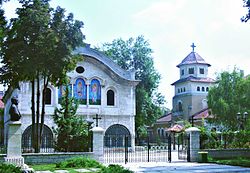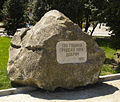- Dobrich
-
Dobrich
ДобричThe Church of Saint George 
Coat of armsLocation of Dobrich Coordinates: 43°34′N 27°50′E / 43.567°N 27.833°E Country Bulgaria Province
(Oblast)Dobrich Government – Mayor Detelina Nikolova Elevation 225 m (738 ft) Population (Census February 2011)[1] – City 91,030 – Urban 113,111 Time zone EET (UTC+2) – Summer (DST) EEST (UTC+3) Postal Code 9300 Area code(s) 058 Dobrich (Bulgarian: Добрич) is a town in northeastern Bulgaria, the administrative centre of Dobrich Province. With 91,030 inhabitants, as of February 2011,[1] Dobrich is the ninth most populated town in Bulgaria, being the centre of the historical region of Southern Dobruja. It is located 30 km west of the Bulgarian Black Sea Coast, not far from resorts such as Albena, Balchik, and Golden Sands.
Dobrich Knoll on Livingston Island in the South Shetland Islands, Antarctica is named after Dobrich. A point of interest is the Dobrich TV Tower.
Contents
History
The first evidence of settlement in what is now Dobrich dates from 4th-3rd centuries BC. Ruins from AD 2nd-4th century and 7th-11th century have also been found, including a Bulgar necropolis featuring pagan graves in the centre of the city.
During the 11th century, Pecheneg invasions devastated the interior of Dobruja, leaving many settlements in the region uninhabited at the time of the Second Bulgarian Empire.
The settlement was founded for a second time in the 16th century by the Turkish merchant Hacıoğlu Pazarcık, whose name it bore until 1882. According to Ottoman data from 1646–1650, there were over 1,000 houses in the city, about 100 shops, three inns, three Turkish baths, twelve mosques and twelve schools.
From the 17th to the 19th century, the city developed as a handicraft, trade and agricultural centre, being famous for its weaving, homespun tailoring, coppersmith's trade, leather-work and agricultural products, such as wheat, linseed, wool and cheese.
At the beginning of the 19th century, the city's population reached 12,000, many of whom refugees from eastern Bulgaria after the Russo-Turkish Wars. The cultural appearance of the city was also formed. The first Orthodox church was built in 1843.
The city was liberated from the Ottoman Empire on 27 January 1878 and renamed Dobrich on 19 February 1882 after Dobrotitsa, a medieval ruler of Dobruja. This was done by means of a decree issued by knyaz Alexander I.
After the Treaty of Bucharest of 1913 (confirmed by the Treaty of Neuilly of 1919), Dobrich and the whole of Southern Dobruja were incorporated in Romania for a period until 1940. During that time, the city bore the name Bazargic and was centre of Caliacra County (judeţ in Romanian). On 25 September 1940, the Bulgarian army marched into the city after signing Treaty of Craiova on September 7, 1940; date celebrated as the city's holiday, later changed to September 25.
During the period of Communist rule, Dobrich was renamed Tolbukhin (Толбухин) after Marshal of the Soviet Union Fyodor Tolbukhin. On 19 September 1990, a presidential decree restored the city's old name of Dobrich.
Population
2001 census data states that about 86% of Dobrich's inhabitants are ethnic Bulgarians, followed by Turks at 8% and Roma at 3.5%. The percentage of Orthodox Christians is 86%, whereas 10% of the population are adherents of the Muslim faith.
According to census 2011, Dobrich has a population of 89,472 inhabitants as of February 2011.[1] The number of the residents of the city reached its peak in the period 1986-1991 when exceeded 110,000.[2] The following table presents the change of the population after the liberation of the country in 1878.
Dobrich Year 1887 1910 1934 1946 1956 1965 1975 1985 1992 2001 2005 2009 2011 Population 10,717 17,146 no data 30,522 42,661 55,191 86,663 109,170 104,485 100,000 93,802 92,672 89,472 Highest number 116,066 in 1991 Sources: National Statistical Institute,[1][2][3] „citypopulation.de“,[4] „pop-stat.mashke.org“,[5] Bulgarian Academy of Sciences[6] Social institutions
Education
Higher Education:
- Dobrudza Technological College http://www.tu-varna.bg/tu-varnakd/
- College of Education of Shoumen University "Ep. Konstatine Preslavski"
- International University College http://vumk.eu/
- Medical college (closed in 2006)
There are about 30 high schools, 19 kindergartens and 3 mangers in Dobrich.
Notable natives
- Dora Gabe - poetess
- Dimitar Spisarevski - famous fighter pilot
- Ivaylo Petrov - poet
- Boncho Genchev - footbal player, 4th in the 1994 FIFA World Cup with the Bulgarian national team
- Preslava - pop-folk singer
- Miro - singer
See also
- List of cities in Bulgaria
- Dobrudja
Twin cities
 Pinsk, Belarus
Pinsk, Belarus Golmud, People's Republic of China
Golmud, People's Republic of China Zalaegerszeg, Hungary
Zalaegerszeg, Hungary Kavadarci, Republic of Macedonia
Kavadarci, Republic of Macedonia Nowy Sącz, Poland
Nowy Sącz, Poland Constanţa, Romania
Constanţa, Romania Saratov, Russia
Saratov, Russia Schaffhausen, Switzerland
Schaffhausen, Switzerland Kırklareli, Turkey
Kırklareli, Turkey Izmail, Ukraine
Izmail, Ukraine
Gallery
-
Khan Asparuh (reign 668–695) monument, credited for establishment of the First Bulgarian Empire in 681
-
The Church of St George in the centre of Dobrich, to the left is the statue of Vasil Levski by Kolyo Bogdanov
References
- ^ a b c d (Bulgarian)National Statistical Institute - Main Towns Census 2011
- ^ a b (Bulgarian)National Statistical Institute - Towns population 1956-1992
- ^ (English) Bulgarian National Statistical Institute - towns in 2009
- ^ (English) „WorldCityPopulation“
- ^ „pop-stat.mashke.org“
- ^ (Bulgarian) Bulgarian Academy of Sciences
External links
- The modern website of Dobrich (Bulgarian)
- Info Dobrich (Bulgarian)
- City of Dobrich
- The official site of Municipality Dobrich (Bulgarian)
- A guide to Dobrich (Bulgarian)
- Dobrich Information and Photos
Coordinates: 43°34′N 27°50′E / 43.567°N 27.833°E
Balchik · Dobrich · Dobrichka · General Toshevo · Kavarna · Krushari · Shabla · Tervel
Categories:- Populated places in Bulgaria
- Dobrich Province
- Dobrich
Wikimedia Foundation. 2010.










